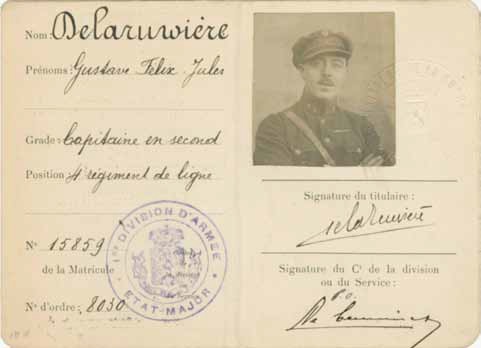| Previous page | Back to exhibition’s homepage | Next page |
|
Underground activities in the 1930s |
Underground activities during the Thirties |
Underground activities during the years 1930 |
| Blao – BOX | Blao – BOX | Blao – BOX |
| Between 1921 in 1939 works, first in Paris and then in Brussels, A Tripartite Intelligence Service, composed of representatives of the British, French and Belgian secret services. This intelligence service is first called Blao (Occupation army liaison office). After the abolition of military safety, this service is from 1930 under the name box (Bureau of Exchange) redesigned. The Blao-Box can be considered as the logical continuation of the collaboration that arose during the First World War between these three services at the Folkestone interalled agency. | Between 1921 and 1939, a tripartite intelligence office composed of representatives of British, French and Belgian secret services is operationals, first from Paris, then from Brussels. This office was known as BLAO ("Occupation army liaison office"). After the suppression of the military security, it was reconstituted in 1930 as BOX (Bureau of Exchange). BLAO-BOX can be considered as the logical continuation of the collaboration that existed, during the First World War, between those three services within the intra-alliance intelligence bureau at Folkestone. | Between 1921 and 1939 works, In Paris first, then in Brussels, A tripartite information office made up of representatives of British secret services, French and Belgian. This office is called Blao (Occupation army liaison office). After the abolition of military security, This service is reconstructed in 1930 Under the name of box (Bureau of Exchange). Blao-Box can be considered the logical continuation of collaboration that existed between these three services in the Interallié Office of Active Folkestone during the First World War. |
| Counter-information service | Counter-information service | Counter-information service |
| The German REEMPLATION allows the General Staff of the Belgian Army to restore the military intelligence and counterpionage service. It Royal decree of 27 mei 1937 gives the second section the since 1929 Public safety reduced powers, Together with a corps of civilian agents. To keep the new service secret for abroad, but also for the Belgian press and politicians, the Royal Decree is not published in the Official Gazette. | Facing the German rearmament, the General Staff of the Belgian army tried to reinstall a military intelligence and security service. Together with a body of civil agents, the royal decree of 27 May 1937 gave this service the competence back which had been transferred to the Public Security in 1929. To keep the existence of this new service a secret for foreigners as well as for the Belgian press and politicians, the royal decree was not published in the Moniteur Belge. | Faced with German rearmament, The Belgian army staff strives to reinstall a military intelligence and counteration service. Skills transferred since 1929 public security is returned to him, as well as a body of civilian agents, by one royal decree of 27 may 1937. To keep secret the existence of the new service both with regard to the stranger and to the press and the Belgian political world, The royal decree is not published in the Belgian instructor. |
| The deliberately vague «Service de Contre-Information» (SCI) is entrusted to Major Mampuys. In his fight against German espionage, the SCI cannot do less than before the war 43 unmasking agents. | Deliberately endowed with a vague name, The “counter-information service” (SCI) was under the command of Major Mampuys. In its struggle against the German espionage, before the Second World War, the SCI was able to arrest no less than 43 agents. | Appointed by the deliberately vague title of "counter-information service" (SCI), This is entrusted to Major Mampuys. In his fight against German espionage, The SCI Unmasks before the war no less than 43 agents. |
Under the arrested spies is Belgian lieutenant Joseph Dombret, of the Military Cartographic Institute. Under influence of his girlfriend Simone Pierlot, he sold secret military documents to a German agent.
Among the arrested spies is the Belgian Lieutenant Joseph Dombret, from the military cartographic Institute. Encouraged by his friend Simone Pierlot, he sold classified material from the army to a German intermediary.
Among the spies arrested is the Belgian lieutenant Joseph Dombret of the Military Cartographic Institute. Led by his Friend Simone Pierlot, He delivered documents against a German intermediary to pay the national defense to a German intermediary.
